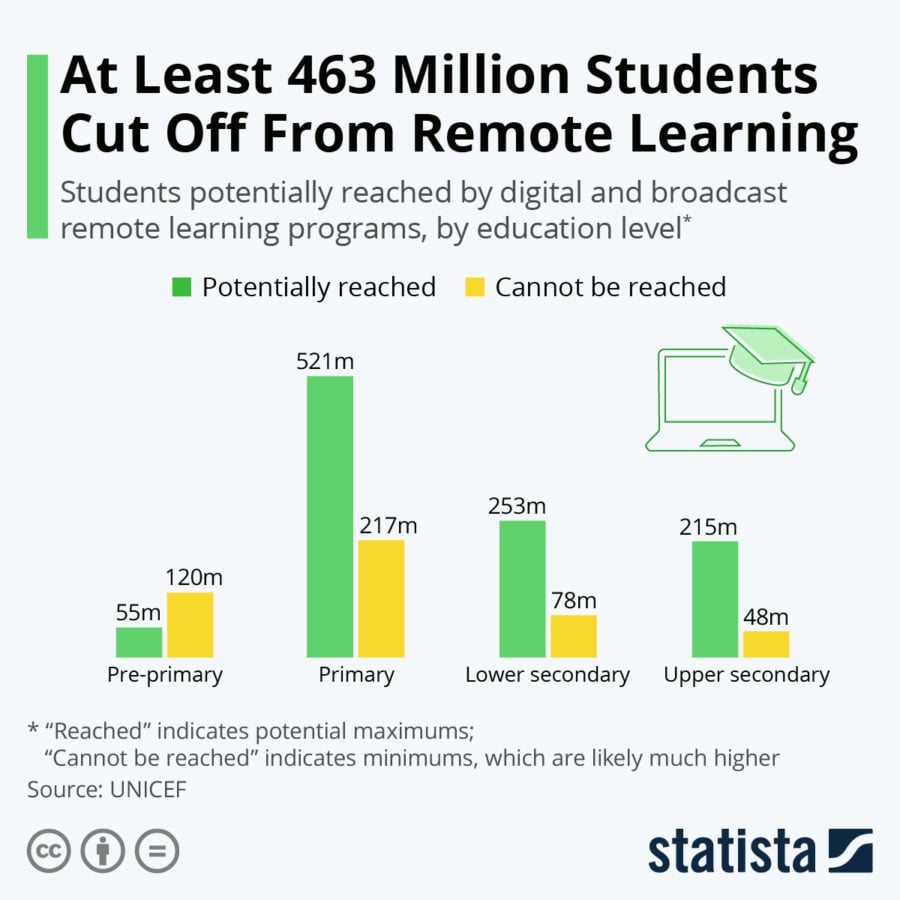Muhammad Hashir is in the second year of A levels at The City School, Ravi Campus, Lahore. His main interest lies in the integration of technology and public service delivery.
Introduction
With a population of nearly 221 million, Pakistan has one of the largest workforces in the world. Yet, 58 million of its population aged over 15 is illiterate (UNESCO, n.d.). The problem of education has long been a major hindrance to the economic and social development of Pakistan. 22 million children (44%) aged 5-16 are currently out of school in Pakistan (Faran & Zaidi, 2021). This does not translate to a bright future. Rather, it paints a grim picture of a future with an inadequate workforce and a stark lack of expertise to propel the country towards prosperity.
The question that then arises is what brought Pakistan to this crucial point in its history where it needs to quickly implement an effective policy to address the woes of the education sector. Perhaps, it is the fact that Pakistan only spends 2.8% of its GDP on education, significantly less compared to the minimum requirement of 4% (Gill, 2021).
There are also various socio-economic factors that prevent children from attending school. Social norms have also prevented a huge chunk of the female population from gaining access to education. Various administrative and policy changes have been implemented or are currently being implemented to address these socio-economic factors. Historically, these have not been much successful.
COVID 19 has highlighted digital initiatives as a potential alternative to conventional forms of education. This is a relatively foreign concept in Pakistan, but its emergence has led to a new debate that this research will shed light on. This research will focus on whether or not digital initiatives have the potential to increase access to education in Pakistan.
Literature Review
It is imperative to understand a few key terms for the purposes of this research. In terms of accessibility to schools in a geographical capacity, accessibility is school availability within a minimum spatial distance. Digital initiatives in education are generally characterized as steps taken to increase digital learning—remote learning, long-distance learning, and learning through technological means.
The United Nations Educational, Scientific and Cultural Organization’s (UNESCO) digital initiatives towards education are centered around reducing inequalities in this sector, empowering disenfranchised communities such as women, and offsetting the geographical limitations of accessibility to education (“Digital Learning is the Way Forward,” 2021).
Prior researchers have found that digital initiatives in education have been on a rapid rise over the past few years. Similarly, increased access to technologies can lead to a plethora of diverse opportunities to teach and learn. However, on the other side of the spectrum, many researchers have raised concerns when it comes to the sustainability of digital initiatives in schools (Aesaert, van Braak, Van Nijlen & Vanderlinde, 2015).
Oftentimes, the focus on the technology itself shrouds the application of that technology in a manner that might translate to tangible change and development in the education sector. It is the opinion of many researchers that for a paradigm shift in the digital landscape of education, there is a dire need to implement digital initiatives on several organizational layers (Pettersson, 2018).
This points to the fact that there are multiple facets of the education sector when discussing any potential digital initiatives. This translates to the case of Pakistan where a wide range of factors affects the delivery of any initiative, be it digital or not. These are often socio-economic, geographical, and administrative in nature.
The COVID-19 pandemic has fueled a new debate regarding digital initiatives in education in Pakistan. In 2020, digital learning has been on a rise in all parts of the globe. Due to the pandemic, 36% of global survey schools were forced to adopt digital learning platforms (Husain, 2021). In Pakistan however, this highlighted a myriad of problems.
Due to a lack of accessibility to the internet in poorer and remote areas, several students have been disadvantaged (Lal, 2021). A lack of access to any digital resources within these areas has created a massive divide when it comes to the accessibility to education between different social strata. This divide is also highlighted in other parts of the world such as India and South Africa.

Provincial and federal governments in Pakistan have, historically and recently, taken steps to address these issues. The use of tele-education and radio education has been increased to enable a higher percentage of students to gain access to classes from the confines of their homes. Moreover, on an administrative level, provincial governments have experimented with the use of administrative measures such as digital human resource (HR) management tools to ensure attendance and digital land management tools to manage and assess the availability of schools in various geographical areas (“Punjab first-ever digital policy. 2020).
Before the pandemic, there have rarely been universal digital curriculums. Due to this, there has been a steep learning curve for teachers. Governments and organizations, however, have undertaken professional training programs to ensure digital literacy. This research will take into consideration all of the above-mentioned factors and analyze them in the context of digital initiatives as a long-term solution to improving access to education in Pakistan.
Methodology
For this paper, both primary and secondary research has been conducted. Articles and research papers have been used to evaluate the digitalization of education and access to education in Pakistan and globally. Moreover, government websites have been used to gain information regarding ongoing initiatives in the education sectors of Pakistan.
For primary research, an online survey was conducted to evaluate different internet and education resources in the rural areas of Pakistan. An online survey was collected because it allows data from all over Pakistan to be collected. Furthermore, it increases the participation of various demographics and diversifies the sample. This survey will be used to have a rough estimate from a random sample of the resources available in Pakistan.
Findings
Survey
A total of 18 individuals, from mostly Punjab and Khyber Pakhtunkhwa (KPK), took part in the survey conducted by the author. In the survey, it was asked if the village each responder belonged to had a primary school, 4G or 3G internet, and cable tv. They were also asked if radios were common in their area and if Internet Service Providers (ISPs) offered their services there.
The survey found that 44% of the responders had a weak 4G connection in their rural area, 50% had a decent connection while 5.6% did not have a 4G connection. 77.8% had a decent 3G connection in their area, while 16.7% had a weak connection. Alarmingly, 5.6% of the responders did not have any 3G reception within their area. 77.8% of responders have cable tv in their village while 22.2% do not. 50% of the villages do not have ISPs in their area. Radios were found to be uncommon in the villages of 61.1% of the responders. All of the responders had a primary school in their area.
Simply the presence of schools, however, does not indicate the full picture. According to Pakistan Education Statistics 2016-17, 42,892 primary schools out of Pakistan’s 150,000 do not have electricity and nearly 8,400 schools do not have a building (Sheikh, n.d.). Security, one of the prime concerns regarding the education of girls, still remains a major concern.
28,700 primary schools were reported to be without a boundary wall. These concerns have caused 52% of the girls at the primary level to be out of school (Sheikh, T.H., n.d.). These facilities, or the lack thereof, indicate that while schools are present, they do not have the resources to accommodate a huge chunk of the 5-16 aged demographic. This explains the alarmingly high primary dropout rate of 41%, which further contributes to out-of-school children (Sheikh, T.H., n.d.).
Increasing the Access to Education: Government Initiatives
The Punjab Information Technology Board (PITB) implemented the School Information System (SIS) in 2017 to maintain a digital record of the enrollment and retention of students at all of the public schools of Punjab (“School Information System,” n.d.). The database also has the records of the parents of the students to increase their accountability.
One limitation of this initiative is the fact that it has no mechanisms whatsoever to store information of private schools. Secondly, while this does keep a record, it does not have any built-in measures to increase the metrics of enrollment and retention. That is entirely dependent on administrative prowess and follow-ups in leu of this data. This initiative, being in its infancy, will only reveal its efficacy in the long run. Such initiatives have also been implemented in other parts of the country.
Another initiative of PITB is the eLearn.Punjab initiative. This is a pilot program that has rolled out tablets for teachers, LEDs in classrooms, and tablet-based smart labs to around 250 classrooms. The purpose of this initiative is to test these technologies for the purpose of a mass rollout (“Elearn.Punjab,” n.d.). This seems to be a good step in the right direction. A few questions do arise though; whether these initiatives will be effective and whether the government has the resources for a mass rollout, can only be answered with the passage of time.
Teleschool and Radio School are two initiatives taken by the Federal Ministry of Education. They are aimed at providing education to children from the confines of their houses in an interactive and engaging manner. Pakistan Television (PTV) covers 90% of Pakistan’s territory and 63% of Pakistani households have access to televisions (Naviwala, 2020). This means that the Teleschool project has massive potential to bring about a significant change in terms of improving access to education.
It also largely mitigates socio-economic factors, such as girls not being allowed to leave their homes, that might prevent access to education for children. Radio School, although similar in nature, cannot be as interactive and it remains to be seen if the dwindling usage and popularity of the radio would be a hindrance. These initiatives are still relatively new, and only time will inform us of their tangible impacts.
Problems in the Path of Digital Education in Pakistan
When it comes to improving access to education through digital initiatives, a significant number of problems exist in Pakistan. There is still a massive gap that needs to be filled in terms of providing 4G connectivity and ISPs to rural areas. These problems with digital education in Pakistan are further aggravated in remote areas such as the extreme north. Without adequate connection infrastructure, it is very difficult to implement remote online learning programs.
Secondly, a significant number of rural areas still lack cable television. It is necessary for the government to improve infrastructure in this regard in order to ensure the maximum efficacy of its Teleschool initiative. An effective Teleschool program can also prove to be very cost-effective as the maintenance and operation costs are quite less in comparison to physical schools.
3.3 million of Pakistan’s children are still trapped in child labor (“Children Forced to Child Labour,” 2021). Children engaged in economic activities due to family pressure do not find the time to study or attend school. To improve access to education, and to overcome the problems pertaining to education in Pakistan, it is imperative for the government to take steps that will alleviate the socio-economic conditions of families and substantially reduce the need for child labor.

Resolving these education problems is essential for any digital initiative to be successful in Pakistan. A similar issue is social factors that prevent access to education for girls. Digital initiatives offset the problem in the short term by removing the need for girls to leave their houses. However, long-term solutions are required such as creating awareness that will propel a larger percentage of the female population to get access to education. Possible solutions, however, are out of the scope of this paper.
Issues pertaining to HR management, school building maintenance, and lack of resources such as electricity are major hindrances in improving access to education. The government has taken digital initiatives to ensure that the first two problems are dealt with. However, it is too soon to evaluate their tangible outcomes. On the other hand, lack of electricity is a problem for initiatives such as remote learning as well.
Conclusion
Remote learning digital initiatives face a myriad of challenges such as inadequate resources and infrastructure and a lack of skilled HR to run these programs. However, these have the ability to significantly improve access to education in remote areas and offset certain economic and social factors as well.
It is important to consider that digital initiatives on an administrative level, such as digital school records and HR management have the potential to increase transparency and improve administrative efficiency. Hence, even in the absence of remote learning initiatives, digital initiatives do have significant benefits that can improve access to education.
With the increase in smartphone usage and the gradual increase in internet usage, Pakistan has the groundwork to implement these initiatives in the longer run. However, they cannot be successful without addressing the problems highlighted in this research paper. Pakistan also needs to step away from its alarmingly low education budget. A higher budget can result in investment for long-term digital initiatives and address the huge lack of resources in the education sector. A long-term, multi-faceted approach might yield massive dividends in the educational sector.
References
- 3.3 million children forced to child labour. (2021). The Nation. https://nation.com.pk/13-Jun-2021/3-3m-children-forced-to-child-labour.
- Aesaert, K., van Braak, J., Van Nijlen, D., & Vanderlinde, R. (2015). Primary school pupils’ ICT competences: extensive model and scale development. Computers & Education, 81, 326–344.
- Digital learning way forward. (2021). UNESCO. https://en.unesco.org/news/digital-learning-way-forward-high-population-countries-rally-around-initiative.
- Elearn.Punjab. (n.d.). PITB. https://pitb.gov.pk/elearn_punjab.
- Faran, H.Z., & Zaidi, Z. (2021). The missing third: An out-of-school children study of Pakistani 5-16 year-olds. Dawn. https://www.dawn.com/news/1643918.
- Gill, T. (2021). CARE: Increasing access to education in Pakistan. The Borgen Project. https://borgenproject.org/education-in-pakistan-2/.
- Husain, A. S. (2021). Education: The future of digital education. Dawn. https://www.dawn.com/news/1636577.
- Lal, D. (2021). The challenges of online education in Pakistan. Paradigm Shift. https://www.paradigmshift.com.pk/challenges-of-online-education/
- Naviwala, N. (2020, April 23). How ‘Teleschool’ Can Revolutionize Pakistan’s Education System. United States Institute of Peace. https://www.usip.org/blog/2020/04/how-teleschool-can-revolutionize-pakistans-education-system.
- Pettersson, F. (2018). On the issues of digital competence in educational contexts – a review of literature. Education and Information, 23. https://link.springer.com/article/10.1007/s10639-017-9649-3.
- Punjab set to have first-ever digital policy. (2020). The News. https://www.thenews.com.pk/print/759925-punjab-set-to-have-first-ever-digital-policy.
- School information system for public schools. (n.d.). PITB. https://pitb.gov.pk/sis.
- Sheikh, A. (n.d.). Rural Pakistan’s untold education crises. Academia. .
- Sheikh, T. H. (n.d.). Enrolment, Drop Out Rates, and Out-of-School Children in Public Primary Schools. Social Enterprise Development Centre.
- UNESCO. (n.d.). Pakistan. https://uis.unesco.org/en/country/pk.
If you want to submit your articles and/or research papers, please check the Submissions page.
The views and opinions expressed in this article/paper are the author’s own and do not necessarily reflect the editorial position of Paradigm Shift.



















